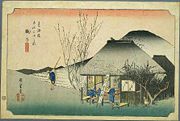
Mariko-juku
Encyclopedia

53 Stations of the Tokaido
The are the rest areas along the Tōkaidō, which was a coastal route that ran from Nihonbashi in Edo to Sanjō Ōhashi in Kyoto.-Stations of the Tōkaidō:...
of the Tōkaidō
Tokaido (road)
The ' was the most important of the Five Routes of the Edo period, connecting Edo to Kyoto in Japan. Unlike the inland and less heavily travelled Nakasendō, the Tōkaidō travelled along the sea coast of eastern Honshū, hence the route's name....
. It is located in what is now part of Suruga Ward
Suruga-ku, Shizuoka
is one of three wards of Shizuoka, Shizuoka, Japan, located in the southern part of the city. The north east of Suruga-ku faces Aoi-ku; the north west faces Shimizu-ku; the south west faces Yaizu city and south east faces Suruga Bay....
in Shizuoka City
Shizuoka, Shizuoka
is the capital city of Shizuoka Prefecture, Japan, and the prefecture's second-largest city in terms of both population and area. It became one of Japan's 19 "designated cities" in 2005.-Geography:...
, Shizuoka Prefecture
Shizuoka Prefecture
is a prefecture of Japan located in the Chūbu region on Honshu island. The capital is the city of Shizuoka.- History :Shizuoka prefecture was formed from the former Tōtōmi, Suruga and Izu provinces.The area was the home of the first Tokugawa Shogun...
, Japan
Japan
Japan is an island nation in East Asia. Located in the Pacific Ocean, it lies to the east of the Sea of Japan, China, North Korea, South Korea and Russia, stretching from the Sea of Okhotsk in the north to the East China Sea and Taiwan in the south...
. It can also be written as 丸子宿 (Mariko-juku).
History
Mariko-juku was one of the smallest post stationsShukuba
were post stations during the Edo period in Japan, generally located on one of the Edo Five Routes or one of its sub-routes. They were also called shukueki . These post stations were places where travelers could rest on their journey around the nation...
on the Tōkaidō. Old row-houses from the Edo period
Edo period
The , or , is a division of Japanese history which was ruled by the shoguns of the Tokugawa family, running from 1603 to 1868. The political entity of this period was the Tokugawa shogunate....
can be found between Mariko-juku and Okabe-juku
Okabe-juku
was the twenty-first of the fifty-three stations of the Tōkaidō. It is located in what is now the city of Fujieda, Shizuoka Prefecture, Japan. Between Okabe-juku and the preceding post station of Mariko-juku runs Route 1, which has part of the ancient trade route....
, its neighboring post station, in Utsuinotani. This post town also had strong ties to the Minamoto
Minamoto clan
was one of the surnames bestowed by the Emperors of Japan upon members of the imperial family who were demoted into the ranks of the nobility. The practice was most prevalent during the Heian Period , although its last occurrence was during the Sengoku Era. The Taira were another such offshoot of...
, Imagawa
Imagawa clan
The was a Japanese clan that claimed descent from Emperor Seiwa . It was a branch of the Minamoto clan by the Ashikaga clan.-Origins:Ashikaga Kuniuji, grandson of Ashikaga Yoshiuji, established himself in the 13th century at Imagawa and took its name.Imagawa Norikuni received from his cousin the...
and Tokugawa
Tokugawa clan
The was a powerful daimyo family of Japan. They nominally descended from Emperor Seiwa and were a branch of the Minamoto clan by the Nitta clan. However, the early history of this clan remains a mystery.-History:...
clans.
The classic ukiyoe print by Ando Hiroshige (Hoeido edition) from 1831-1834 depicts two travellers at a wayside teahouse, from which another traveller has just departed.
Further reading
- Carey, Patrick. Rediscovering the Old Tokaido:In the Footsteps of Hiroshige. Global Books UK (2000). ISBN 1901903109
- Chiba, Reiko. Hiroshige's Tokaido in Prints and Poetry. Tuttle. (1982) ISBN 0804802467
- Taganau, Jilly. The Tokaido Road: Travelling and Representation in Edo and Meiji Japan. RoutledgeCurzon (2004). ISBN 0415310911

